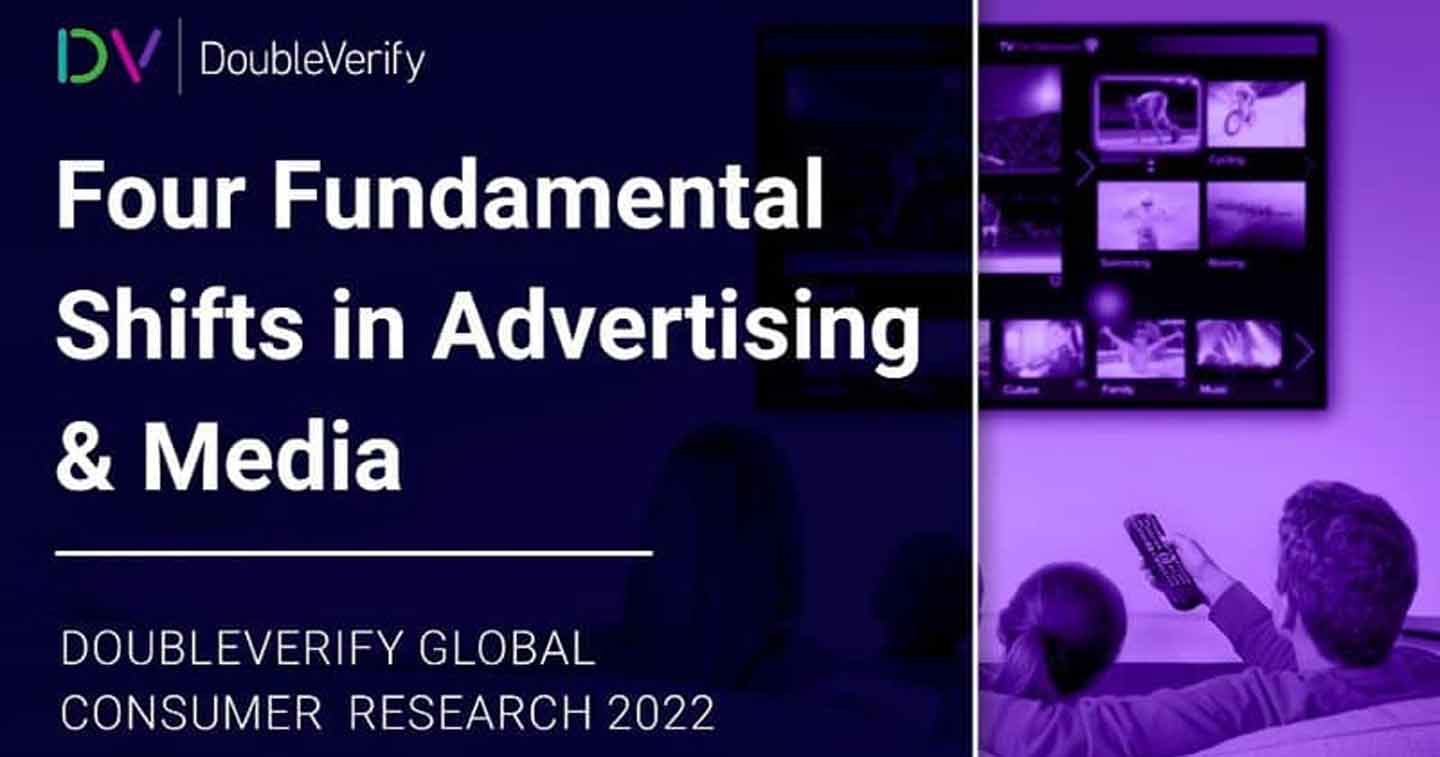SINGAPORE — DoubleVerify (DV), a leading software platform for digital media measurement, data, and analytics, has released its 2022 “Four Fundamental Shifts in Advertising and Media” report. Two years on from DV’s original report, this expanded edition analyzes insights from over 16,600 global consumers in 18 countries. At a time of significant macroeconomic change, these findings reveal the dynamic relationships between consumers, digital content, and advertising — arming stakeholders with the insights they need to make well-informed strategic decisions.
Key takeaways include:
- Cost of living concerns drive “stay at home” content consumption — particularly on CTV and social media — with most (55%) consumers now spending more time-consuming content daily than they did pre-pandemic.
- Attention fuels media efficacy — two-thirds (66%) of respondents claimed an ad that captures their interest in the first five seconds will make them more likely to pay attention.
- Online shopping surges and is bolstered by a contextual approach — 54% of respondents report buying more items online now than pre-pandemic, while 67% are more likely to pay attention to an ad if it’s relevant to the content they’re viewing — such as reviews or gift ideas.
- Trust and shared values foster loyalty, but consumers are quick to judge. Consumers are concerned about the spread of mis- and dis-information, and it shows — 61% are even less likely to purchase/use a brand again if they see it advertised beside mis-/dis-information.
“This study highlights that consumer consumption habits are evolving in response to macro social and economic trends, from intensifying concerns about inflammatory or polarizing content to a continued shift in the platforms and channels consumers are turning to for content consumption,” said DoubleVerify CEO Mark Zagorski. “Brands must react to these changing habits to ensure they reach the right audiences as efficiently as possible and maximize their digital investments. As our research shows, with digital content consumption rising, there’s a clear opportunity to garner consumer attention and power campaign performance. To unlock this opportunity, brands must evolve their ad strategies — meeting their audiences where they consume content and focusing on contextually relevant, attention-grabbing ad placements that also safeguard their brand reputations.”
Consumer appetite for content continues to soar — led by CTV, streaming, and social
Globally, most (55%) consumers are spending more time each day consuming content now than they did pre-pandemic. In APAC, this is higher than the global average at 68%. Inflation is a key driver with almost half (45%) of respondents globally noting the reason they’re spending more time consuming digital content is that they are staying at home due to the rising cost of living. In APAC, this is at 40%, whereas the increasing availability of quality content (49%), interest in the latest trends and topics (48%) as well as work-from-home tendencies (45%) are the top reasons for increasing content consumption.
CTV (Connected TV) and streaming services have clear momentum, with 55% having subscribed to additional subscription services in the past 12 months. In APAC, this is higher than the global average at 60%. Meanwhile, 38% here expect to spend more time on social media in the year ahead.
With costs under consumer scrutiny and digital content consumption rising, ad-supported content represents a growing opportunity for advertisers, with 66% in APAC open to ad-supported video streaming apps if it cuts prices.
Brands must address attention fragmentation — or risk losing consumers
Survey respondents reported that they believe they see between 1 and 50 ads per day — estimates suggest the true average figure is around 4,000.**
Where ads appear determines their impact, according to consumers. YouTube dominates as the number one proprietary platform for securing the attention of respondents in 15 out of 18 countries surveyed — followed by Facebook (39%) and Instagram (28%).*** Newer platforms continue to attract consumer time and engagement. TikTok is rapidly growing, and 43% of 18 to 24-year-olds report they plan on spending more time in the app over the next 12 months.
Timing is essential for APAC audiences with two-thirds stating that they are more likely to pay attention if a video ad isn’t too long (71%) and if an ad catches their interest in the first five seconds (72%). Among all regions, APAC stood out with 50% stating that ads with celebrities and influencers would capture their attention. The region was also among one of the top markets that would pay attention to ads that play audio automatically with 49% of consumers reporting that they would do so.
Shopping’s digital maturity presents a new opportunity for brands to make an impact
Online shopping continues to grow as most consumers, 54%, report buying more items online now than they did pre-pandemic. In APAC, this is one of the highest among the regions at 63%.
Pre-purchase habits are also evolving, with over half (53%) highlighting they use digital content to inform planned purchases more often than they did before the pandemic — in the APAC region this is a notable 66%. Over two-thirds (74%) of APAC consumers say they are more likely to pay attention to an ad if it’s relevant to the content they’re looking at — such as reviews or gift ideas. This reinforces the importance of contextually relevant ad placements.
Brand values are key as consumers demand accountability on mis- and dis-information
Likely exacerbated by polarized news and opinions, the majority of consumers in APAC (71%) are concerned that levels of mis- and dis-information**** are increasing — and brands must be conscious of ad adjacency. In fact, 63% of APAC respondents would be less likely to purchase/use the brand again if they saw it advertised next to content that they determined to be mis/disinformation.
The majority of survey respondents globally (82%) state they have been exposed at some point to mis-/dis-information on social media. In APAC this is 89%.
Brand action on mis-/dis-information will be rewarded with trust from consumers. The majority (71%) in APAC value brands that actively fight against mis-/dis-information and 72% state that companies that are genuine and authentic appeal to them.
DoubleVerify APAC Managing Director Jordan Khoo said: “On top of the growth in online content consumption globally, a growing number of consumers in APAC are relying on digital content more than before when making purchases. We are helping advertisers lean in on these insights and tap into relevant periods in this region, such as the Mega Sales Days and Black Friday that take place in November and December, to maximize their advertising dollars.”
Jordan furthered, “Along with a growing emphasis on brand accountability for mis- and dis-information, advertisers also need to relook at their strategies to ensure their ads are reaching the right target audience without risking their brand reputation. At DV we continue to focus on supporting our clients with balancing protection and scale, especially with the continuously evolving news cycle.”
For the full 2022 “Four Fundamental Shifts in Advertising and Media” report, visit here.








